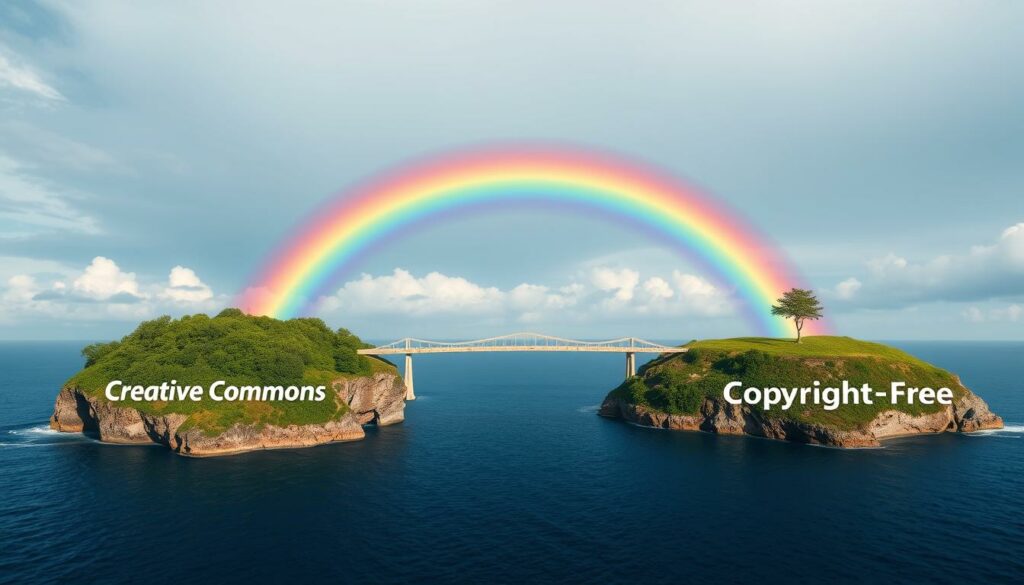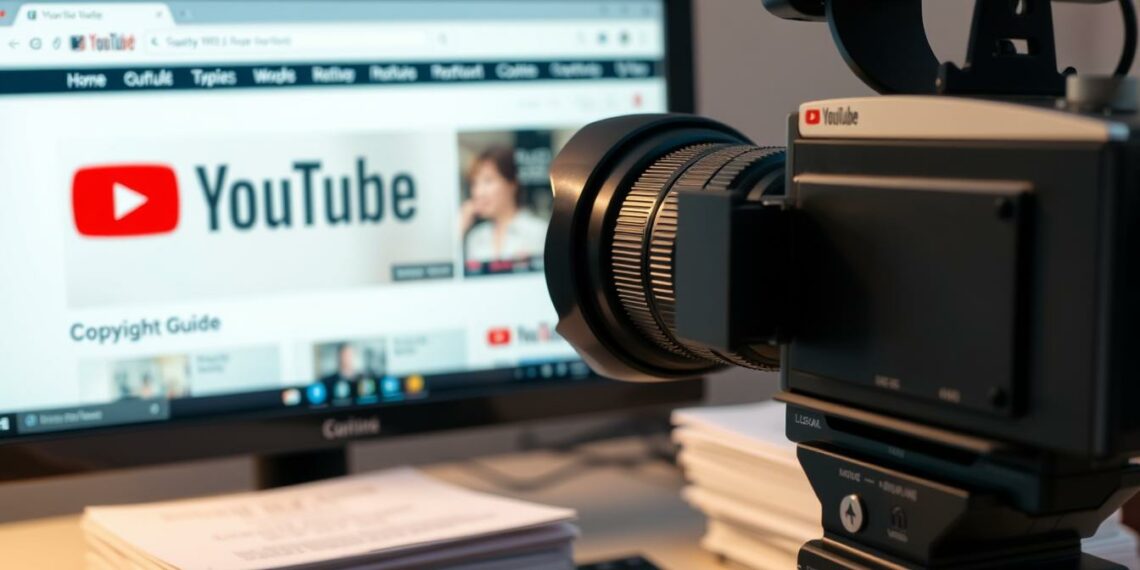Did you know over 90% of online content is under copyright? This fact shows how tricky it can be to share movies on YouTube without copyright problems. Knowing about copyright-free movies, permissions, and YouTube copyright guidelines is key.
This guide will help you share movies legally on your channel. You’ll learn about Creative Commons licenses, public domain films, and royalty-free options. It’s important to know these to avoid legal issues, like video takedowns or channel termination.
For more on how creators like The Anime Lord share anime videos legally, check out this informative resource. Understanding your rights helps you grow your YouTube channel legally.
Key Takeaways
- Understanding copyright is vital to avoid legal issues when uploading content.
- Fair Use doctrine allows limited use of copyrighted material without consent.
- Licensed content and royalty-free movies are accessible through various platforms.
- Creative Commons music offers opportunities for creators to use music legally.
- Public domain films can be uploaded without copyright concerns.
Understanding Copyright and Its Importance
Copyright is a key protection for original works. It keeps the rights of creators safe over their content. Knowing the copyright definition helps you understand the legal rules for using music, images, and films. Copyright starts automatically when a work is made. Creators don’t have to file for it or renew it, a rule that started in 1992.
Definition of Copyright
Copyright gives creators special rights to use and share their work. They can decide how their content is shared or made money from it. For example, they can block a video on YouTube or let it make money. Using copyrighted material without permission is a big no-no and can lead to big legal trouble.
Consequences of Copyright Infringement
Using copyrighted stuff on YouTube without permission can lead to big problems. Copyright owners can make you lose money or views on your videos. Copyright strikes can even close your account after three times, but claims don’t directly hurt your channel. They just make your content harder to see.
YouTube uses a powerful Content ID system to check millions of videos every month for copyright issues. After a copyright strike, you must take an online course about copyright. If you ignore the rules, you could face copyright claims and even lose your account in 90 days if you get three strikes.
YouTube Copyright Guidelines
YouTube copyright guidelines are key for content creators who want to share videos. They help you avoid copyright issues. The platform says you can only upload content you own or have permission for. Breaking these rules can cause big problems.
Overview of YouTube's Policies
YouTube’s rules protect both creators and copyright owners. If you make recap videos, you need to be careful to avoid copyright claims. You can plan and edit your videos to avoid issues.
YouTube lets creators deal with copyright problems without harsh penalties. But copyright strikes are more serious and come from official requests to take down content.
Content ID System Explained
The Content ID system is crucial for YouTube’s copyright checks. It automatically looks for copyrighted material in videos. If it finds something, it might lead to copyright claims.
Copyright owners can track, make money from, or block videos that use their work. This system checks all kinds of videos, even private ones. So, it’s key to follow YouTube’s copyright rules.
Good ways to share recap videos include using clips under seven seconds. You can also speed up or slow down footage. Using guides and tutorials can help you make engaging videos without breaking rules.
How to Upload Movies to YouTube Without Copyright
When you think about uploading movies without copyright problems, it’s key to know about licensing options. Getting the right permissions helps avoid copyright issues. By looking into different places to get licenses, you can make sure your content is legal.
Key Permissions Required
To upload movies to YouTube without trouble, you need to get the right permissions. These can include:
- Talking directly with content owners to get the rights.
- Using platforms that offer licensed stuff under certain rules.
- Looking into the fair use doctrine for special cases.
How you upload movies affects your ability to make money without copyright problems. The fair use doctrine lets you use copyrighted stuff in limited ways. But, it’s tricky to follow. It’s best to keep summaries short and don’t use big clips without permission.
Resources for Licensing and Permissions
There are many places to help you get the licenses you need:
- Music libraries with soundtracks you can use legally.
- Websites that sell different types of media for a fee.
- Tools to talk to creators directly for permission.
Checking out these resources helps protect your uploads and lets you make engaging videos. Channels like Story Recapped are popular for making movies into shorter, 10 to 15-minute clips.

| Resource Type | Description | Example Providers |
|---|---|---|
| Music Libraries | Platforms offering music with licenses for commercial use. | AudioJungle, Epidemic Sound |
| Licensing Services | Websites providing access to licensed visuals and audio. | Artlist, Pond5 |
| Direct Negotiation | Talking to content creators for access to their work. | Use social media, email outreach |
Creative Commons and Copyright-Free Movies
When you’re looking for videos on YouTube, knowing about Creative Commons licensing is key. This system lets creators share their work legally and sets rules for how others can use it. By using these licenses, you can find great videos to share without worrying about legal trouble.
What is Creative Commons Licensing?
Creative Commons licensing lets creators share their work with the public but with some rules. These rules help with sharing and using the work while keeping the original creator’s rights. You must follow these rules, which can include giving credit or not using the work for money. This way, creators can share their work and others can use it legally.
Where to Find Creative Commons Movies
You can find lots of copyright-free movies online. Here are some top places:
- Internet Archive: A huge library with many digital movies, from classics to unique broadcasts.
- Wikimedia Commons: A big database with over 33 million free media files, including videos.
- NASA Videos: Educational videos from NASA that you can use for free.
- Public Domain Videos on Vimeo: A collection of HD videos you can use for anything.
Use the search tools on these sites to find videos with the right Creative Commons licenses. This makes sure you’re using the videos legally and avoids copyright issues.
It’s important to know the rules of Creative Commons licenses. Each one has its own rules, like needing credit or not changing the work. Make sure to learn these rules to use the content right. Using Creative Commons helps share creative work fairly and respects the original creators.

Using Public Domain Films for YouTube Uploads
When you think about using public domain films for YouTube, it’s key to know what they are. These films are in the public domain, meaning no one owns the copyright. This makes them great for creators who want to use content without worrying about legal issues.
Definition of Public Domain
Public domain films are works with no copyright protection. This means anyone can use them freely. Most films made before January 1, 1926, fall into this category. They can also become public domain if copyright expires or if they were never eligible for copyright in the first place.
How to Identify Public Domain Films
It’s important to research the copyright status of films to find public domain ones. Here are some steps to follow:
- Check the film’s publication date—look for those before 1926.
- Use databases like the Library of Congress to see if they are in the public domain.
- Look at trusted sources that list copyright-free films.
Before uploading a film, make sure it’s really in the public domain. Getting it wrong could lead to copyright issues. For more info on using fair use on YouTube, check out YouTube’s fair use guidelines. Knowing these rules helps you use public domain films safely and legally on YouTube.
Royalty-Free and Stock Footage Options
Looking for top-notch visuals for your YouTube videos? Royalty-free content is a great choice. It comes with a license that lets you use it forever after paying once or agreeing to certain terms. This way, you avoid copyright issues, which is key for any creator aiming for professional quality without legal trouble.
What is Royalty-Free Content?
Royalty-free content includes videos and music you can legally add to your projects. It’s super useful for YouTube creators because it helps you stand out in a crowded space. With stock footage, you can make your videos more appealing without the hassle of copyright issues.
Best Sources for Royalty-Free Movies
There are many websites with lots of royalty-free footage. Pixabay has over 2.7 million videos you can use for free. Videvo also has thousands of clips, with some free and others you can pay for. Pexels and Mixkit offer a wide range of free stock footage for commercial use without needing to credit anyone.
By checking out these sites, you can make your YouTube videos look great and be legally okay. This makes your channel more interesting and follows the law.
FAQ
How can I upload movies to YouTube without violating copyright?
To upload movies to YouTube without breaking copyright laws, focus on public domain, Creative Commons, or royalty-free content. Always check the copyright status of any material you plan to share.
What is the difference between copyright and public domain?
Copyright gives the creator exclusive rights to their work, protecting it from unauthorized use. Public domain works, on the other hand, are free for anyone to use without permission.
Can I use clips from copyrighted movies under the fair use doctrine?
The fair use doctrine allows limited use of copyrighted material for certain purposes like commentary or education. But, each situation must be carefully analyzed as fair use is not always clear-cut.
What platforms can I use to find Creative Commons licensed films?
Look for Creative Commons licensed films on platforms like Internet Archive, Vimeo, and YouTube’s Creative Commons section. Always follow the license’s attribution guidelines to stay legal.
How can I make sure a film is in the public domain before uploading?
To check if a film is in the public domain, look at its publication date and copyright status. Works published before January 1, 1926 are usually public domain. Use resources like Copyright.gov or public domain databases for confirmation.
What is royalty-free content, and how do I use it?
Royalty-free content is media you can use without paying royalties after a one-time agreement. Find royalty-free movies and stock footage on various websites. Always follow the licensing agreement’s usage rules.
What are the consequences of copyright infringement on YouTube?
Copyright infringement on YouTube can lead to copyright claims, strikes on your account, and even channel termination. It’s important to follow YouTube’s copyright guidelines to avoid these issues.
How does YouTube’s Content ID system work?
YouTube’s Content ID system scans uploaded videos for copyrighted content automatically. If a match is found, the copyright owner can choose to monetize, block, or track the video. Knowing how this system works can help prevent copyright problems.




